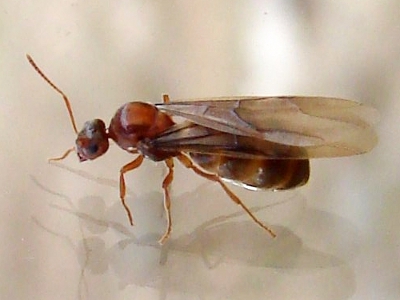False Honey Ants
Category: Ants

Facts about False Honey Ants, "Scientific name False Honey Ants is prenolepis impairs". False Honey Ants are one of the many bizarre forms of wildlife in the Australian desert. Oddly, they store the honey dew which is produced by aphids. However, there is another kind of ant, that appear to look like the honey ants, hence the name "false honey ants". False honey ants are commonly found in the United States and parts of Canada. The False Honey Ants are also referred to as "the winter ants". "Fear of Ants Myrmecophobia".
Unlike many ant species, False Honey Ants forage during the winter months when the temperature is just around zero, hence the name "the winter ants". Very few ants in the world are active in these cold temperatures. In fact, they are normally the only visible ants active in zero or subzero temperatures. Though still unknown, the False Honey Ants do not extend into the far northern parts of Canada, despite their resistance to cold weather.
The False Honey Ants like to build nests in soil that has clay in it, staying inactive during warm months. They are also known to nest under rocks or logs. The False Honey Ants often choose oak or maple for their nesting grounds.
Like other species of ants, false honey ants have males, queens, and the workers. Workers mainly consume honey dew, secretions from flowers, sap, earthworms, arthropods, and decaying fruit. The worker measures up to about 2.5 to 3.5 millimeters. The regular male is between 3.0 and 4.0 millimeters. The false honey queen ant is one of the largest ant queens, measuring about 8 millimeters in length. An interesting fact is that worker ants of the False Honey Ants species are fed to the point that they swell with fat. Then a glandular secretion is produced which acts as the main source of food for the single year.
The prenolepis imparis is usually triangular in shape. They have 5 to 6 teeth, and on rare occasions 7 teeth. The False Honey Ants have a gleaming, shinny head with a dark brown abdomen. The antennae are brown at the base, but yellow at the tips. The color gives the idea that the False Honey Ants are darker in the middle and lighter on each end. Viewing the ant also reveal an hourglass shape, which is one of their distinguishing features.
The false honey ants usually mate from the month of March to April, with most of the mating taking place on the ground. The False Honey Ants mating time is still known as nuptial flight despite the fact that most of it takes place on the ground; this is because the false honey ants still fly during this period. After the mating, the females start a new nest, and the broods appear in autumn. The broods only become adults over winter.
False Honey Ants can lift and carry three times their weight.
False Honey Antsare omnivores like humans, an omnivores, (definition-they eat both other animals and plants).
The False Honey Ants are also known to invade homes. They will often be found where there are food remains and wastes especially during winter. Food left out during winter attracts them to the compounds. Plants provide an entry way into the homes for the False Honey Ants and they will usually invade homes with untrimmed plants. Just like all ants, the False Honey Ants are social creatures and they travel in bunches. They will usually invade a home in a big number. The way False Honey Ants communicate is by using chemicals called (pheromones) they can alert other ants where food and also if danger is coming.
The male False Honey Ants usually have only one role in life, mating with the queen and after they have performed their duty, they can die.
There are more than 20,000, Ant species around the world, there have been 12,500 that have been classified in specific species.
Ants are the longest living insect of all times they live up to 30 years.
Ants have two stomachs, one that holds food for them to eat and one for other the colony.
You can find Ants on every continent accept Antarctica.
Ants can survive around a full day underwater.
The Queen False Honey Ants only job in life is to lay 1000 of eggs in their life time. All worker, soldier and queen False Honey Ants are female. The worker False Honey Ants, that you see running around, the wingless False Honey Ants are females that don't reproduce, these are the False Honey Ants that hunt for food and take care for the queen's offspring, protect the community and work on the nest and other community duties.

 Back To Category Ants
Back To Category Ants